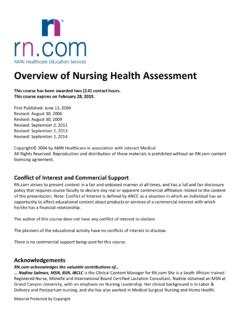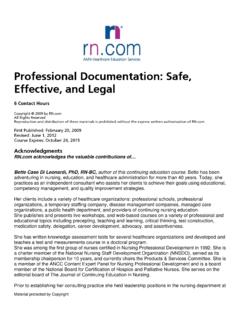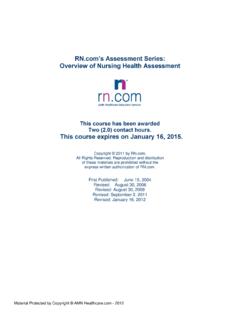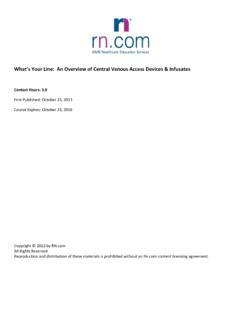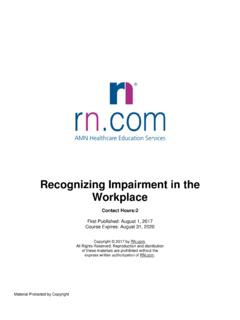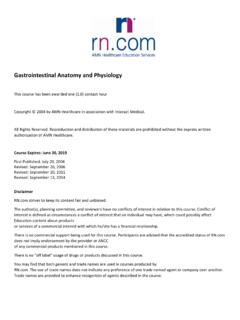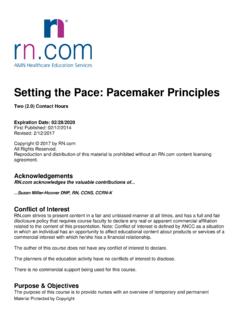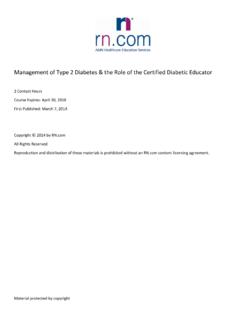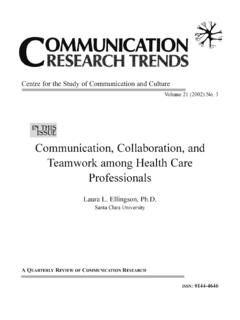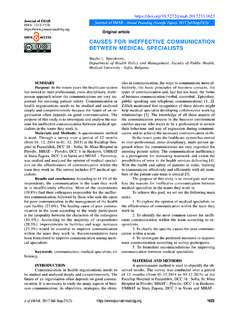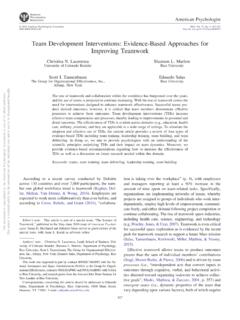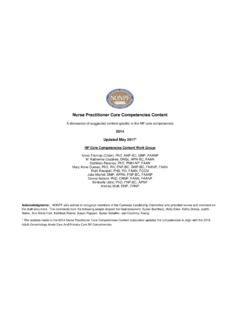Transcription of Interprofessional Collaboration
1 Interprofessional Collaboration One ( ) Contact Hour Course Expires: 1/31/2019. First Published: 6/20/2013. Reproduction and distribution of these materials is prohibited without the express written authorization of Acknowledgements acknowledges the valuable contribution ..Jodi O'Brien, RN. Upon graduating from the University of Rochester in 2002, Jodi gained experience as a medical surgical nurse. Since her move to San Diego, in 2005, she has held adjunct faculty teaching positions for local colleges and now cares for women and newborns as an OR nurse. As Jodi expands her scope of practice, she is a graduate student in the Executive Nurse Leadership Program at the University of San Diego and is a member of Sigma Theta Tau. This is her first time writing for Conflict of Interest strives to present content in a fair and unbiased manner at all times, and has a full and fair disclosure policy that requires course faculty to declare any real or apparent commercial affiliation related to the content of this presentation.
2 Note: Conflict of Interest is defined by ANCC as a situation in which an individual has an opportunity to affect educational content about products or services of a commercial interest with which he/she has a financial relationship. The author of this course does not have any conflict of interest to declare. The planners of the educational activity have no conflicts of interest to disclose. There is no commercial support being used for this course. Material protected by copyright Purpose and Objectives Upon completion of the course, the nurse will be able to: The purpose of this one contact hour continuing education course for nurses is to present information about Interprofessional Collaboration and its significance in the healthcare setting, and to define the role of the nurse in improving Interprofessional Collaboration in the healthcare setting.
3 Define Interprofessional Collaboration . Describe the role that Interprofessional Collaboration plays in delivering safe patient and family centered care. Identify the purpose of Interprofessional Collaboration . List the four competencies of Interprofessional Collaboration . Discuss how the nurse may help improve the healthcare organization's adoption of an Interprofessional Collaboration approach in the delivery of care. What is Interprofessional Collaboration ? Interprofessional Collaboration has been defined by many. However, most authorities would accept the definition of Interprofessional Collaboration to be when: Multiple health workers from different professional backgrounds work together with patients, families, caregivers, and communities to deliver the highest quality of care (WHO, 2010). Loosely defined, Interprofessional Collaboration is a partnership that starts with the patient and includes all involved healthcare providers working together to deliver patient and family centered care.
4 The term Interprofessional is becoming one of the most widely used terms in conjunction with Collaboration in the healthcare vernacular and is also emerging in the literature as a hot topic of focus for healthcare researchers. The term " Interprofessional " is the updated version of older terms such as, interdisciplinary, cross-disciplinary, and trans-disciplinary. Did you know? An example of Interprofessional Collaboration would be a doctor, nurse, physical therapist, occupational therapist, and pharmacist working together to carry out an individualized plan of care in order to improve a patient's health status. Interprofessional Collaboration : Not a New Concept Lowell T. Coggeshall was a physician who began his career in 1928 and championed for advancement of medical progress though education. In 1965, Coggeshall suggested, the concept of medicine as a single discipline concerned with only the restoration of individual health from the diseased state should be replaced by the concept of health professions working in concert to maintain and increase the health of society as well as the individual.
5 In 1970, Jerome P. Lysaught suggested advancing the practice of nurses by educating nurses at universities and increasing the number of graduate programs. The historical report titled, The Lysaught Report, released by the national commission for the Study of Nursing and Nursing education, also Material protected by copyright recommended nurses and physicians work together to improve patient care. In 1972, the Institute of Medicine (IOM) recommended the advancement of health teams, and by 2000. the IOM Crossing the Quality Chasm series highlights the implications of NOT taking on the challenges to successfully deliver high quality and safe care to patients. Test Yourself The term, Interprofessional Collaboration , is new but the concept has been documented as early as: a. 1985. b. 1928 - Correct! c. 1960. d. 2000. History and Timeline of Interprofessional Collaboration Events that Preceded Interprofessional Collaboration Historically, widespread patient errors in US hospitals have been associated with substantial preventable morbidity and mortality.
6 Errors identified in the patient care setting vary in severity and range in complexity from simple medication errors to fatal compromises in patent safety. Material protected by copyright In addition, major quality issues of traditional care delivery methods have been identified, calling for much needed change to the present approach. The breakdown or deficiencies in communication among healthcare professionals, particularly between nurses and doctors, can directly contribute to the destabilization of the environment in which care is provided, and negatively impacts the patient whom care is centered around. Poor communication between health professionals is not only associated with a rise in mortality but with increase length of hospital stay and higher hospital readmission rates. The groundbreaking Institute of Medicine (IOM) report, To Err is Human, supports the need for healthcare professionals to focus on communication and the facilitation of effective communication and for professional societies to set standards and communicate to members the importance of securing the safety of patients.
7 The tradition of doctor-centric healthcare environments is being replaced. Gone are the days when one person writes an order, and another person follows it. Everyone's input (patient, family, and all persons involved in the patient's care) is important and should be assessed objectively. By doing so, the patient benefits. Healthcare systems and experts agree that risk reduction strategies must be employed per the Joint Commission's recommendations to reduce the occurrence of sentinel events. A Closer Look at Interprofessional Collaboration A review of the literature reveals certain concepts which are mentioned repeatedly in the various definitions of Interprofessional Collaboration . among the most common were: sharing, partnership, interdependency and power (D'Amour, Ferrada-Videla, Rodriguez, & Beaulieu, 2005). Researchers (D'Amour et al.)
8 , 2005) also affirm that Interprofessional Collaboration is a dynamic process, and that it is improbable that by simply bringing healthcare professionals together, Collaboration will occur. Rather, trust must be established and an appreciation of each others' roles must be gained in order for effective Collaboration to take place. Health professionals must recognize their own individual scope of practice and skill set AND have an awareness of and appreciation for other health professionals capacity to contribute to the delivery of care to patients in order to achieve optimal health outcomes. Interprofessional Collaboration is an updated version to the traditional team approach to healthcare. Test Yourself A condition of established trust and respect of other health professionals contributions must be met in order for Interprofessional Collaboration to take place.
9 A. True - Correct! b. False Achieving Goals with Interprofessional Collaboration There are several goals that may be achieved through Interprofessional Collaboration . Interprofessional Collaboration is considered to be the most critical instrument in reducing patient care errors. It is widely accepted that Interprofessional Collaboration may improve communication between Material protected by copyright all health professionals. Another goal is to coordinate care among health professionals so that inefficiencies in healthcare such as delays in (or lack of) treatment, redundancies in care, or inappropriate use of services may be eliminated. Another goal is to reduce overall healthcare costs. The employment of Interprofessional Collaboration methods may help to build a safer and better patient-centered and community/population-oriented US healthcare system.
10 Test Yourself Goals that may be achieved with Interprofessional Collaboration include: a. Lower healthcare costs b. Reduced patient errors c. Improved communication d. All of the above - Correct! Paving The Way For Interprofessional Collaboration The seminal IOM report, To Err is Human (1999) attempted to quantify the number of needless deaths due to errors and poor quality care. In 2003, TJC reported that communication failures among team members are a contributory factor in 60% of sentinel events. In 2005, communication failures were the leading root cause of all sentinel events (Joint Commission on the Accreditation of Healthcare Organizations. Joint Commission Perspectives, 2006). Did you know? This report has been widely credited with launching efforts to study and improve safety in healthcare. National Organizations Lead the Movement The groundbreaking Institute of Medicine (IOM) report, The Future of Nursing: Leading Change, Advancing Health (2010), was a call for a transformed healthcare system in which Interprofessional Collaboration and coordination are the norm.
